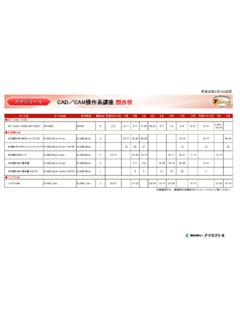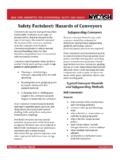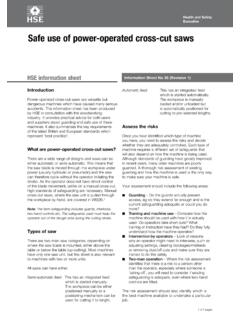Transcription of Press Brake Safety Guide - AMADA
1 Press Brake Safety Guide (For employers and employees)Seventh editionFebruary 2016 This Safety Guide is an English translation of Japanese Safety Guide based on Japanese laws and comply with your country's laws and regulations if you are outside of Preface1 This Safety Guide provides employers and employees with important Safety information they should know when they take safeguarding measures for AMADA Press information for using Press brakes is also available in the operator s manuals of Press brakes and the warning labels affixed to the Press brakes. Before you use the machine, fully understand all of these pieces of Safety Safety Guide introduces safeguarding measures that can be retrofitted to your Press Brake . Fully recognize hazards associated with machine installation, workpiece and tool setup, machine operation, inspection, cleaning and maintenance, and other tasks.
2 On your own responsibility as employer, take safeguarding measures to suit the environment of your shop and the method of using your machine. Also conduct Safety and health education for your Industrial Safety and Health Act states that employers must take machine safeguarding measures.(See Responsibilities of employer on the next page.)Several examples of safeguarding are introduced here. safeguarding devices recommended by AMADA are offered as options. Please study and adopt you retrofit safeguarding devices to your already installed machine, you may have to modify the machine and its controls. When you study what safeguarding devices to adopt, please contact machine safeguarding procedures, etc., refer to Guidelines for the Comprehensive Safety Standards of Machinery published by the Ministry of Health, Labour and Welfare (LSB Notification No.)
3 0731001, revised on July 31, 2007).To see the guidelines, go to the website of the Japan Advanced Information Center of Safety and Health ( ), click the Laws, Regulations and Notifications button, enter No. 0731001 , and find the LSB Notification No. Responsibilities of employer2 The Industrial Safety and Health Act (hereinafter referred to as Act) and Ordinance on Industrial Safety and Health (hereinafter referred to as Ordinance) mainly impose the following duties on employers who have their workers use machines, in order to reduce industrial accidents.(1) Notifying of plans- Notify the Labour Standards Office of the Labour Standards Office of plans to install, relocate or alter machines, etc. (Article 88 of Act and Article 85 of Ordinance)Notify the Labour Standards Office of such plans, have the plans checked for Safety , and receive guidance about the Notify the competent government office of a specified facility and apply to the competent government office for permission to use the specified the specified facility falls under the provisions of the Noise Control Act, the Vibration Control Act and the environmental conservation ordinance of the competent local government, notify the competent environmental conservation contact office of the specified the notification duties, control values, etc.
4 , vary from region to region, check the details at the competent environmental conservation contact office.(2) Investigating hazardousness and harmfulnessInvestigate the hazardousness and harmfulness of tasks and duties (or assess the risks of tasks and duties). Take necessary measures to prevent hazards to workers or prevent the health disorders of workers. (Article 28-2 of Act)For data concerning residual risks peculiar to specific machines and required to perform risk assessment, contact AMADA .(3) Preventing hazardsTake appropriate safeguarding measures to ensure the Safety of Press operators. (Article 20 of Act and Article 131 of Ordinance)Protect workers from hazards from machines, hazardous materials, and electricity and other energy measures to prevent the body parts of workers from entering the hazardous area.
5 (4) Appointing chief operatorAppoint a qualified chief operator. (Article 14 of Act and Article 16 of Ordinance)In a workplace with five or more power presses, appoint a chief operator from among workers given technical (5) Conducting Safety and health educationConduct Safety and health education to workers who operate the machine for the first time. (Article 35 of Ordinance)Provide special education to workers who change or adjust tools. (Article 36 of Ordinance and Article 3 of Rules on Special Safety and Health Education)(6) Inspecting before start of day s workInspect the machine before the start of the day s work. (Article 136 of Ordinance)Try to find equipment failures and faults as soon as possible. If a problem is found, repair it or take any other necessary measure to prevent an accident.
6 (7) Conducting special voluntary inspectionConduct legal inspection by qualified personnel once or more per year. (Article 135 of Ordinance)Repair any problems found by the inspection, and file the inspection results and repair records.(1) Light curtainLight beams are projected at the front of the point of operation. When an obstruction interrupts the light beams during the ram fast stroke, the ram stops. The ram does not stop during the opening process as the obstruction interrupts the light beams. To ensure a Safety distance, the light curtain cannot be used when bending small parts and parts with long side flanges unless the function is higher Safety , it is necessary to provide auxiliary light beams as shown below if the operator is likely to reach between the main light beams and the front edge of the bed.
7 It is also recommended to install side guards (Note 2) at the sides of the 1: Light curtains are called Safety device when certified so by the Ministry of Health, Labourand 2: For side guards, see section (3). 3. Introduction of safeguarding measures4 The following equation for calculating the Safety distance is specified in the Power Press Construction Code(Japanese Law):D = ( Tl + Ts ) + CWhereD: Safety distance (mm) : Operator s hand speed (m/s)Tl: Time from interruption of light beams by operator s hand to operation of light curtain (ms)Ts: Time from operation of light curtain to stop of ram (ms)C: Distance added for Press Brake (0 mm when minimum object sensitivity (MOS) is 30 mm or less)Ts is sudden stop time and Tl + Ts is maximum stop time.*Tl and Ts vary with the Safety devices used and the distance Main lightbeams Auxiliary lightbeams Two or more laser beams are projected between the punch and die at the point of operation.
8 When an obstruction interrupts the laser beams during the ram closing process, the ram stops. The ram does not stop during the opening process as the obstruction interrupts the laser laser beams are located just below the punch. This means that the laser beam device can be used when bending small parts and parts with long side the ram comes to the mute point, it decelerates to a crawl speed of 10 mm/s or laser beam device complies with the type test requirements of Japan and is CE marked as category 1: Bending from the mute point involves the risk of getting hands pinched between the workpiece and tool/upper ram stops when the laser beams are interrupted if speed is over 10 without standing side flanges Workpiece with standing side flangesRam pauses at side flange position and then closes when CLOSING foot pedal is pressed again.
9 Normal modeNormal modeBox modeBox modeField muted modeField muted modeMute stop modeMute stop mode Laser beams LZS(2) Laser beam device5 Laser beams Mute pointLaser beam device is mutedRam operates only at crawl speed of 10 mm/s or less. This mode is used for changing tools or performing special bending operations (like hemming).Ram pauses at mute point and then closes when CLOSING foot pedal is pressed guards at the sides of the side guards reduce the risk of the operator getting the hands pinched when the operator reaches between the punch and die from either side of the machine or reaches between the backgauge and (3) Side guards(4) Rear guard(5) Three-position(Antipanic) foot pedalPrevents entry from the rear of the machine. The rear guard reduces the risk of the operator getting the hands pinched between the punch and die or getting impacted by the is especially effective in protecting operators other than the main and auxiliary foot pedal of three-step ram is stopped in the first step.
10 Press the foot pedal in the second step to start the ram. Strongly Press it in the thirdstep to stop the the operator loses balance during the bending operation and strongly Press the foot pedal with hands inserted between the punch and die, the ram stops. When feeling a dangerous situation, an operator tends to push hard instead of releasing. In this way, the three-position foot pedal reduces the risk of the operator getting hands pinched between the punch and (6) Sheet followerInstalled at the front of the machine and supports operator need not support sheets. When sheets are particularly heavy, the fatigue of the operator is lessened throughout the bending sheet follower also reduces the risk of the operator getting injured on the face, for example, by the unexpected whip-up of the sheet.












